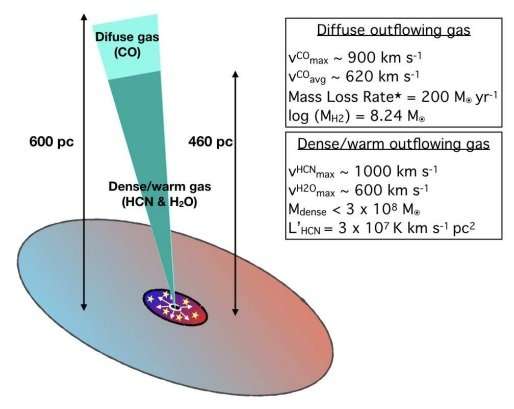Sketch of the blue-shifted molecular outflow in the northern nucleus of Mrk 273. Credit: Aladro et al., 2018.
An international group of scientists has recently conducted a study of molecular gas in the northern nucleus of an ultra-luminous infrared galaxy known as Markarian 273. The research, which reveals physical and chemical properties of the galaxy's disc and its outflow, was presented in a paper published May 30 on arXiv.org.
Located some 512 million light years away, Markarian 273 (Mrk 273 for short) is an ultra-luminous infrared galaxy (ULIRG) of Seyfert type II. The galaxy showcases a complex morphology, which could be a result of a recent merger event between two or more galaxies.
Previous observations of Mrk 273 revealed that its northern nucleus has extended gas streamers in the north-south direction, a nuclear disc oriented east-west, and a very compact core containing a powerful starburst. Therefore, astronomers are interested in more studies of molecular gas in this peculiar region of Mrk 273, which could contribute to better understanding the nature of this galaxy and ULIRGs in general.
Now, a team of astronomers led by Rebeca Aladro of the Max Planck Institute for Radio Astronomy in Bonn, Germany, presents the results of new observations of Mrk 273 using the NOrthern Extended Millimeter Array (NOEMA) interferometer, located in France, and ESA's Herschel Space Observatory. The observational campaign obtained essential information about parameters of molecular gas in this galaxy.
"Our observations, extending from the mm to the far infrared regime, allowed us to study the properties of the gaseous disc in the northern nucleus of Mrk 273, as well as the connection between its cold and warm phases," the researchers wrote in the paper.
According to the research, the Mrk 273's disc showcases decoupled kinematics. The astronomers found that the low-excitation gas in the outer parts of the disc extends up to a radius of about 4,900 light years and rotates from south-east to north-west, while the more excited dense gas arising from the central star forming region is characterized by a north-east to south-west rotation.
When it comes to the properties of the disc's outflow, Aladro's team detected the cold (sub-mm) and warm (far infrared) phases of this flux. The new observations show that it is a compact outflow reaching high velocities of around 1,000 km/s, being ejected to distances of 1,500 light years mostly towards the northern direction.
The authors of the paper underlined that the most important finding regarding the chemistry of Mrk 273 is the HCO+ /HOC+ molecular line ratio. They found that this ratio is lower than 10, which means that it is one of the lowest values ever measured in any galactic or extragalactic source. However, the cause of such a low ratio is uncertain and needs to be further investigated.
"The reason for this value, however, is still not clear and should be further studied in detail with the help of chemical models," the paper reads.
In concluding remarks, the researchers added that the origin of HOC+ is different from the rest of the detected molecular species in Mrk 273. This is due to the fact that its emission is spatially shifted from the center.
More information: Molecular gas in the northern nucleus of Mrk273: Physical and chemical properties of the disk and its outflow, arXiv:1805.11582 [astro-ph.GA] arxiv.org/abs/1805.11582
Abstract
Aiming to characterise the properties of the molecular gas in the ultraluminous infrared galaxy Mrk273 and its outflow, we used the NOEMA interferometer to image the dense gas molecular tracers HCN, HCO+, HNC, HOC+ and HC3N at 86GHz and 256GHz with angular resolutions of 4.9x4.5 arcsec (3.7x3.4 kpc) and 0.61x0.55 arcsec (460x420 pc). We also modelled the flux of several H2O lines observed with Herschel using a radiative transfer code that includes excitation by collisions as well as by far-infrared photons. The disk of the Mrk273 north nucleus has two components with decoupled kinematics. The gas in the outer parts (1.5 kpc) rotates with a south-east to north-west direction, while in the inner disk (300 pc) follows a north-east to south-west rotation. The central 300 pc, which hosts a compact starburst region, is filled with dense and warm gas, contains a dynamical mass of (4-5)x10^9M_sun, a luminosity of L'_HCN=(3-4)x10^8 K km/s pc^2, and a dust temperature of 55 K. At the very centre, a compact core with R~50 pc has a luminosity of L_IR=4x10^11L_sun (30% of the total infrared luminosity), and a dust temperature of 95 K. The core is expanding at low velocities ~50-100 km/s, probably affected by the outflowing gas. We detect the blue-shifted component of the outflow, while the red-shifted counterpart remains undetected in our data. Its cold and dense phase reaches fast velocities up to ~1000 km/s, while the warm outflowing gas has more moderate maximum velocities of ~600 km/s. The outflow is detected as far as 460 pc from the centre in the northern direction, and has a mass of dense gas <8x10^8M_sun. The difference between the position angles of the inner disk (~70 degree) and the outflow (~10 degree) indicates that the outflow is likely powered by the AGN, and not by the starburst. Regarding the chemistry, we measure an extremely low HCO+/HOC+ ratio of 10+-5 in the inner disk of Mrk273.
© 2018 Phys.org
























